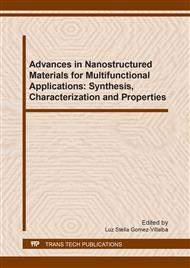[1]
G. Cao, Nanostructures and Nanomaterials: Synthesis, Properties and Applications, Imperial College Press, London, (2004).
Google Scholar
[2]
C. X. Zhao, Y. F. Li, J. Zhou, L. Y. Li, S. Z. Deng, N. S. Xu, and Jun Chen. Large-Scale Synthesis of Bicrystalline ZnO Nanowire Arrays by Thermal Oxidation of Zinc Film: Growth Mechanism and High-Performance Field Emission. Cryst. Growth Des. 13 (2013).
DOI: 10.1021/cg400318f
Google Scholar
[3]
S.A. Colorado, H.A. Colorado, Manufacturing of zinc oxide structures by thermal oxidation processes as scalable methods towards inexpensive electric generators, Ceramics International 43 (2017) 15846-15855.
DOI: 10.1016/j.ceramint.2017.08.156
Google Scholar
[4]
C.L. Zhang, J.J. Li, S.Y. Li, Photocatalytic degradation of pefloxacin in water by modified nano-zinc oxide, Materials Letters, 206 (2017) 146-149.
DOI: 10.1016/j.matlet.2017.06.109
Google Scholar
[5]
X. Wang, C. J. Summers and Z. L. Wang. Large-Scale Hexagonal-Patterned Growth of Aligned ZnO Nanorods for Nano-optoelectronics and Nanosensor Arrays. Nano Lett. 4 (3) (2004) 423-426.
DOI: 10.1021/nl035102c
Google Scholar
[6]
Y. Ortega, P. Fernández and J. Piqueras. Growth and luminescence of oriented nanoplate arrays in tin doped ZnO. Nanotechnology 18 (2007) 115606.
DOI: 10.1088/0957-4484/18/11/115606
Google Scholar
[7]
J. Grym, P. Fernández, J. Piqueras. Growth and spatially resolved luminescence of low dimensional structures in sintered ZnO. Nanotechnology 16 (2005) 931-935.
DOI: 10.1088/0957-4484/16/6/051
Google Scholar
[8]
M. H. Huang, S. Mao, H. Feick, H. Yan, Y. Wu, Hannes Kind, Eicke Weber, Richard Russo, Peidong Yang. Room-Temperature Ultraviolet Nanowire Nanolasers. Science 292 (2001)1897-1899.
DOI: 10.1126/science.1060367
Google Scholar
[9]
H. Yan, R. He, J. Pham, P. Yang. Morphogenesis of One-Dimensional ZnO Nano- and Microcrystals Adv. Matter 15 (5) (2003) 402-405.
DOI: 10.1002/adma.200390091
Google Scholar
[10]
A. El Hichou, M. Addou, A. Bougrine, R. Dounia, J. Ebothé, M. Troyon, M. Amrani. Cathodoluminescence properties of undoped and Al-doped ZnO thin films deposited on glass substrate by spray pyrolysis. Materials Chemistry and Physics 83 (2004).
DOI: 10.1016/j.matchemphys.2003.08.015
Google Scholar
[11]
Y. Fang, X. Wen, S. Yang, Q. Pang, L. Ding, J. Wang and W. Ge. Hydrothermal Synthesis and Optical Properties of ZnO Nanostructured Films Directly Grown from/on Zinc Substrates. Journal of Sol-gel Science and Technology 36 (2005) 227-234.
DOI: 10.1007/s10971-005-3563-7
Google Scholar
[12]
W. I. Park, G. C. Yi, M. Kim, S. J. Pennycook. ZnO Nanoneedles Grown Vertically on Si Substrates by Non-Catalytic Vapor-Phase Epitaxy. Adv. Mater. 14 (24) (2002) 1841-1843.
DOI: 10.1002/adma.200290015
Google Scholar
[13]
H. Y. Dang, J. Wang and S. S. Fan. The synthesis of metal oxide nanowires by directly heating metal samples in appropriate oxygen atmospheres Nanotechnology 14 (2003) 738-741.
DOI: 10.1088/0957-4484/14/7/308
Google Scholar
[14]
A. Umar, S.H. Kim, Y.H. Im, Y.B. Hahn. Structural and optical properties of ZnO micro-spheres and cages by oxidation of metallic Zn powder. Superlattices Microstruct. 39 (2006) 238-246.
DOI: 10.1016/j.spmi.2005.08.046
Google Scholar
[15]
R. Nakamura, J.-G. Lee, D. Tokozakura, H. Mori, H. Nakajima. Formation of hollow ZnO through low-temperature oxidation of Zn nanoparticles. Materials Letters 61 (2007) 1060-1063.
DOI: 10.1016/j.matlet.2006.06.039
Google Scholar
[16]
L. Yuan, C. Wang, R. Cai, Y. Wang, G. Zhou. Temperature-dependent growth mechanism and microstructure of ZnO nanostructures grown from the thermal oxidation of zinc. J. Cryst. Growth 390 (2014) 101-108.
DOI: 10.1016/j.jcrysgro.2013.12.036
Google Scholar
[17]
Y. Du, F. Zeng. Annealing effects on the cathodoluminescence properties of individual ZnO nanowire. Materials Letters 65 (2011) 2238-2240.
DOI: 10.1016/j.matlet.2011.04.006
Google Scholar
[18]
A. Gonzalez, M. Herrera-Saldivar, J. Valenzuela. CL study of yellow emission in ZnO nanostructures annealed in Ar and O2 atmospheres. Superlattices and Microstructures 45 (2009) 421-428.
DOI: 10.1016/j.spmi.2008.10.036
Google Scholar


